FIJI DIGITAL CHARTS
FIJI DIGITAL CHARTS IN MBTILES FORMAT
AHOY !
... join the Ocean Posse to gain access to THIS AND OTHER information >>
JOIN THE OCEAN POSSE _FOR ACCESS TO THIS AND OTHER INFORMATION - SIGN UP HERE >>
ALREADY SIGNED UP ? FOLLOW THIS LINK TO LOGIN >>
The Ocean Posse offers many saving benefits in addition to validate information by fellow yacht owners >>
BENEFITS OF of joining the Ocean Posse
SAVE TIME - SAVE MONEY - and get the best and most up to date INFORMATION !
| BENEFITS FOR YOU, YOUR YACHT & YOUR CREW |
|
|
| PRE SEASON | IN SEASON | |
| ✔️ Up to date and verified information by fellow yachts | ✔️ | ✔️ |
| 📊 Communications focused on facts, not opinions or unsolicited advice | ✔️ | |
| 💰 Save real money at 70+ Marinas with discounts * | ✔️ ( June ) | ✔️ |
| 🛰️ Free vessel and fleet tracking courtesy of Predict Wind | ✔️ | |
| 🚩 Free Burgee | ✔️ | |
| 💰 Save with service providers and chandleries | ✔️ ( June ish ) | ✔️ |
| 🕵️ dedicated, experienced and discounted Canal and clearing in agents | ✔️ | ✔️ |
| 🗺️ Free aid to navigation 150 Gb OpenCPN satellite charts (mac/pc/android) | ✔️ immediately | ✔️ |
| 💰 Save Money on parts with a Westmarine Pro Discount | ✔️ | |
| 💰 Save Money with a Predict Wind Pro Discount | ✔️ | |
| 🗺️ Free Printable Reference Charts emergency backup to your electronics | ✔️ immediately | ✔️ |
| 📹 Free Video Seminars on destinations from those who are there | ✔️ immediately | ✔️ |
| 🌩️ Top weather routing avail by Marine Weather Center Chris Parker | ✔️ | |
| ⛵ Community of voyagers all are welcome, kids, single-handers, pets | ✔️ | ✔️ |
| ⚓ Peer support in emergencies with escalation procedures | ✔️ | |
| 🛈 Fleet Updates via email – free | ✔️ Prior Fleet immediately | ✔️ |
| 🏆 Fun Award Categories | ✔️ | |
| 📍 Free access to GOOD NAUTICAL Anchorage reports | ✔immediately | ✔️ |
| ☎️ Free Weekly live calls on Mondays via dedicated LINE.me group | ✔️ | |
| 💬 Free 24/7 LINE group channel | ✔️end of June | ✔️ |
| 🌊 Benefit from the latest information and prior experience participants | ✔️ | |
| 🔭 Be part of a fleet of sensor for those who come behind you or meet | ✔️ | |
| 🚷 Always priority traffic – for participants by participants | ✔️ |
- (* as long as you do not have prior contracts or reservations in place and of course subject to a marina’s availability the longer you stay the more discount the marina may give you )
If this is agreeable you can sign up now >>
THE ABOVE FILES ARE FOR LOGGED IN USERS ONLY
MANTA RAYS MAJESTIC & MYSTERIOUS
MANTA RAYS : Majestic and Mysterious

Manta Rays are among the most majestic gentle giants in tropical and sub tropical oceans of the world. Seeing them swim under water is a magical sight to behold; with their mouths wide open, manta rays silently move through the water in a slow, effortless, gliding motion, feeding on the smallest of living creatures, plankton, that drift in the ocean currents. Like many species of sharks, mantas are in constant motion to keep water flowing over their gills to breathe. Additionally, mantas are cartilaginous fish meaning their skeleton is made of cartilage like our ears and noses.
There are two species of Manta Rays: the Reef Manta (Mobula alfredi) and the Oceanic Manta (Mobula birostris). No matter the species of manta, With their wings outstretched they dwarf all but large sharks or whales. The reef mantas wings span up to 5 meters while the oceanic mantas wings span up to 7 meters and can weigh up to 2 tons. Manta Rays have the largest brain to body ratio of all living fish and are known to display high levels of intelligence, have long-term memory, and are able to map their environment using sights and smells. The markings on their underside are their unique 'fingerprint'. Much like the marking on the underside of a humpbacks tail, the star-like pattern of whale sharks, and the whisker spots of lions, there are no two exactly alike and these creatures can be identified by their markings that make them unique.

As seen in this photo above there is a mutualism, or mutually beneficial relationship, between mantas and various small hitchhiker fish like remoras. The Remora clings onto the Manta Ray for protection, transportation and scraps from the Manta Rays meals. The Remora benefits the Manta Ray by cleaning it’s skin of bacteria and parasites keeping Mantas healthy. Manta Rays can also be found at 'Cleaning Stations' (or healthy coral patches) sometimes circling close by for up to an hour before moving in for a cleaning and then staying on for hours getting cleaned. In this case the mantas have a symbiotic relationship with cleaner fish (like the cleaner wrasse fish and the scarlet cleaner shrimp). These small fish and crustaceans swim around the larger animals and inside their mouths to eat the parasites, bacteria, and dead skin cells from their bodies. One animal is getting fed while the other is getting cleaned. It's a win-win! Manta Rays will often return to cleaning stations they 'know'.
Manta rays live up to 50 years. The female manta becomes sexually mature a bit later than the male: round 8-10 years of age. Manta rays are ovoviviparous meaning that after fertilization the offspring grows inside an egg (like a bird...but WAIT...there's more)...which the female manta carries inside of her during the pregnancy and give birth to a live fully independent manta ray (live birth like a mammal?!). Mantas give birth to 1-2 manta every 2-5 years. Many details are still a mystery as no one has ever documented seeing a live birth in the wild.

Perhaps because of their size, their grace, their omnipresence in the oceans Manta Rays, and many other characteristics, manta rays have found their way into the art and mythology of many cultures around the world. In Polynesian mythology, for instance, the manta ray is believed to be the guardian of the ocean and a symbol of knowledge and wisdom. In ancient Greek mythology, they were believed to be messengers of the sea god, Poseidon. In ancient Hindu mythology, manta rays are believed to be the manifestation of Lord Vishnu, the creator of the universe. In Japan, manta rays are often associated with the god of the sea, believed to protect sailors and fishermen from danger and provide them good fortune. Interestingly, they are universally seen as protectors and not aggressors, creators not destroyers.
Sadly, as much as manta rays are widely admired to revered their existence is threatened in various ways. Being pelagic, they cross 'borders' constantly and live in a warming ocean that is thereby struggling with habitat loss and teaming with industrialized fishing techniques that do not take care to avoid them (mantas are often 'bycatch' and can die due to suffocation as a result of entanglement.). In some places mantas are specifically sought out for food and bait (for instance in the Sea of Cortez, Mexico) and in the western south Pacific mantas are harvested for their gill plates that are used in Asian Medicine. It is worth noting that in Indonesia, Peru, and the Philippines there now national laws in place to protect manta rays.
Still, in order to protect animals, we need to understand them. Efforts are being made to understand manta distribution, mating, and ecology better to help them. However, Scientific efforts to understand Mantas formally began rather recently around 2008.

According to Mantatrust.org :
Manta rays often undertake seasonal migrations, travelling tens, hundreds, and sometimes thousands of kilometers. This means that their habitat can encompass large areas, sometimes crossing national boundaries, where conservation management is often more challenging. Therefore, to effectively protect these animals, we must first understand what habitats they are using, when they are there, and what they are doing within it.
....It is often a sad fact of human nature that the more endangered a wild animal becomes, the greater our desire to possess or consume it. Diminishing stocks drive a lucrative trade (often illegal) to hunt down, trade in, and consume the dwindling populations of these endangered species.
Interestingly, again there is still so much mystery around mantas that citizen scientists are helping with these efforts. People can communicate directly with the scientists at Manta Trust to help supply information (pictures) to create a 'mantabase' about specific manta individuals to share where they are and begin to help map their health, habitats, and seasonal routes.
If you are a mariner, look out for this incredible species of fish. Maybe you can appreciate their majesty while unlocking some of their mystery.
PASSAGE REPORT: SAMOA TO WALLIS ISLAND
SV VIVA SHARES PASSAGE REPORT:
SAMOA TO WALLIS ISLAND











SOUTH PACIFIC TROPICAL CYCLONE SEASON OUTLOOK
SOUTH PACIFIC TROPICAL CYCLONE SEASON
NOVEMBER 1-APRIL 30
NEW OUTLOOK RELEASED
Tropical cyclones, like hurricanes, are known for their powerful winds, heavy rains, and potential to cause significant destruction. Tropical cyclones frequently affect the southern Pacific and can pose serious threats to both public health and infrastructure. All vessels are advised to have a plan of action for the cyclone season.

According to New Zealand's National Institute of Water and Atmospheric Research (NIWA) and Metservice, the South Pacific may see either fewer or a normal number of tropical cyclones this season. The cyclone season in the South Pacific starts November 1 and runs until the April 30, with the typical 'peak' of the season being January - March. The outlook that has recently been released, "Southwest Pacific Tropical Cyclone Outlook - October 2024" describes a slower start to the Cyclone season, potentially less cyclone risk overall in the eastern region while potentially elevated risk in the western region. According to the NIWA Outlook, "As of early October 2024, sea surface temperatures across the eastern and central equatorial Pacific Ocean are below average and close to La Niña thresholds." Forecasters are observing more La Niña-like characteristics that tend to reduce risk in the east and elevate risk in the west where warmer water may 'stack up' later in the season. As with many weather outlooks of late there continues to be caution that while there may be less risk in the frequency of tropical storms this season, there is still a risk that those that come may intensify more rapidly or simply be very intense.

For cruisers in French Polynesia South Pacific Posse member Scott on Tartaruga shares:
What is critical to following storms in FP is the location of the MJO. Madden Julien Oscillation. You can research that but when that is over French Poly that is when the highest probability of big storms occur. Per some local Tahiti sailors they almost never have any cyclonic storms outside of MJO events. This last season Fiji announced the MJO forecast and when it would be over FP and boom the storms came. Also note that Fiji is the official metrological organization for these storms. Another important data point is they name their storms very early, mean the wind scale starts at a much lower number....NOAA tracks (the MJO) closely as well. I would educate yourself on how to read the graph. It is a bit strange.
Fiji Meteorological Service Regional Specialized Meteorological Centre Nadi-Tropical Cyclone Centre also just released a forecast on the upcoming tropical Cyclone season. Their predictions are similar.

Stay alert on great weather sites including:
- https://www.met.gov.fj/index.php?page=tcoutlook
- https://niwa.co.nz/climate-and-weather/southwest-pacific-tropical-cyclone-outlook/southwest-pacific-tropical-cyclone-outlook-october-2024
FIJIAN CULTURE AND THE SEVUSEVU PROCESS
FIJI: THE SEVUSEVU PROCESS
In traditional villages in Fiji Sevusevu is and has been the central component of all life-cycle rituals, social gatherings, healing ceremonies and community meetings. Significant and ancient in Fiji, the “sevusevu” also marks the time and place for visitors to seek acceptance into a Fijian village.

Every Sevusevu is not as formal as pictured above however there is a distinct and courteous process visitors must follow. Further, understanding the significance of Sevusevu, respecting, and adhering to the tradition of this process helps to keep this aspect of Fijian Culture strong.
Longtime Ocean Posse member Chris on SV SEAGLUB has been living in Fiji for several years. He shares the following about his experience with the Sevesevu:
In Fiji, when visiting smaller settlements, a visitor must seek out the village chief and present him with a small token or gift as a sign of respect and to ask permission to visit. This not only gives visitors permission to interact with the villagers but also to stay in the town and to visit any local scenery (such as beaches, waterfalls etc). Not doing so shows disrespect for their culture, but is also the equivalent of trespassing – for example pitching a tent in someone's backyard without permission.
‘Sevusevu’ is the name given to the actual gift or token that visitors present the chief with, most commonly a half-kilo bumdle of waka (kava root). When arriving in the village, visitors should ask for the Turaga ni Koro (pronounced as too-ranga nee koro) or the village headman, as they usually have good English skills and will help with the translations. The headman will take visitors to the chief’s house for introduction. Remember no hats are to be worn once in the village and you should take your shoes off at the door before entering houses. Sitting cross legged on the floor, the kava root is then presented to the chief.
To ensure you are respectful of this important tradition, there are a few points of etiquette to follow. Firstly, everyone at the ceremony should dress in a sulu, which is a Fijian skirt regarded as their national dress. Women should also cover their shoulders. Men should sit cross-legged, ensuring that their sulu covers their knees, and women should sit with knees and feet together. Do not take photographs or videos throughout the ceremony, until the Turaga ni Koro lets you know that it’s okay to do so. Silence during the ceremony itself is crucial.
The ceremony itself is poignant. Afterwards you'll be welcomed as nothing less than family.
SV SEAGLUB 🇺🇸 Chris -Hylas 46'

NAWI ISLAND POSSE PARTY WRAP UP
SOUTH PACIFIC POSSE PARTY WRAP UP
When the Posse throws a party there is rum, a pig roast, people come and have fun...
It's that simple and it happens every time.
Last weekend the Ocean Posse and Posse sponsor Nawi Island Marina hosted a party at Nawi Island Marina in Savusavu, Fiji. The South Pacific Islands are distinctly different and yet there are many similarities among the peoples ways of celebrating. One such similarity is that celebratory feasting often involves the roasting (wither on a spit or more traditionally wrapped in banana leaves underground in a earthen pit) an entire animal....often a pig. In Fiji, a traditional pig feast is called 'Lovo' (which refers to the earthen oven) and is often the meal that brings large groups of people together for celebrating births, funerals, marriages, welcoming or bidding farewell to visitors, and holidays such as Easter or Christmas. Traditionally, women prepare the meat, men tend the earthen oven or fire, children play, and people are welcome to spend the time visiting and playing while the meal slowly cooks. This method of gathering, cooking slowly, and feasting has been passed down from generation to generation as a living legacy of bonding the importance of relationships within a community. Often other foods like seafoods, other meats, or vegetables are also cooked either in or near the earthen oven similarly wrapped in banana leaves to steam cook slowly. The flavors become distinctly rich and flavorful. When everything is unearthed or done cooking over coals, foods that were wrapped are unwrapped and are traditionally placed on banana leaves and presented buffet style accompanied by fresh squeezed coconut cream and other sauces.
SV WHIMSICAL IV shared their photos from the event:







SV WHIMSICAL IV 
The feast was wonderful. There were about 80 people in attendance that enjoyed a night of good food, drinks, meeting new friends and deepening relationships.
FIJI REGATTA WEEK 2024
UPCOMING EVENT : FIJI REGATTA WEEK
11-15 September, 2024
in beautiful Musket Cove

Registration for the 2024 40th Anniversary Regatta is now open. Please book early!
This link will take you to the Regatta Registration form.
Please note this form is for Regatta Registrations only. For all Marina Berth and Mooring bookings, please email Patrick directly at: mcyc@musketcovefiji.com. Please book early as there are limited Marina Berths available.
https://pacificposse.com/musket-cove-marina
MUSKET COVE MARINA 
SPONSORS THE PANAMA POSSE

We welcome any of the South Pacific Posse to Musket Cove at any time.
We’re pleased to offer a Free Berthing Day for 5 Paid Days to all of your Posse Members.

Wayne Deed
Director of Sales & Marketing
Musket Cove Island Resort & Marina
Malolo Lailai Island
Fiji Islands
m| +64 21 824266
P | +679 666 2215
HISTORY OF BLACKBIRDING REMEMBERED
Australian South Sea Islander National Recognition Day
August 25, 2024
Blackbirding: A Dark Piece of History Remembered

Australian South Sea Islander National Recognition Day is significant as it recognizes the the arrival of the first South Sea Islanders to Queensland, Australia and a distinct cultural group that has become a part of the fabric of Australia's population and heritage. The arrival of the first South Sea Islanders was part of the practice of "blackbirding", or slave-trading, that went on in the mid to late 1800s in the South Pacific. Blackbirding refers to the recruitment, trickery, and outright stealing of people from their native lands forced to labor in distant lands. Labor conditions and pay were notoriously poor to inhumane.
This period of South Pacific history tangles with American history here: the US Civil War was dragging on and dramatically impacting worldwide supplies of sugar and cotton. Furthermore, as the US Civil War came to a close and it was apparent that the South would never be the same again, people from the Confederacy that had the means to escape found their way to the new places to practice their old ways: whether it be cash crops or slave trading. In response, new areas of production were opening up in new parts of the world like Australia, Fiji, and Hawaii. The new areas of production needed cheap laborers. Pacific Islanders, primarily from 80 different islands in Melanesia and Polynesia, were blackbirded and forced to work on new sugar and cotton plantations.
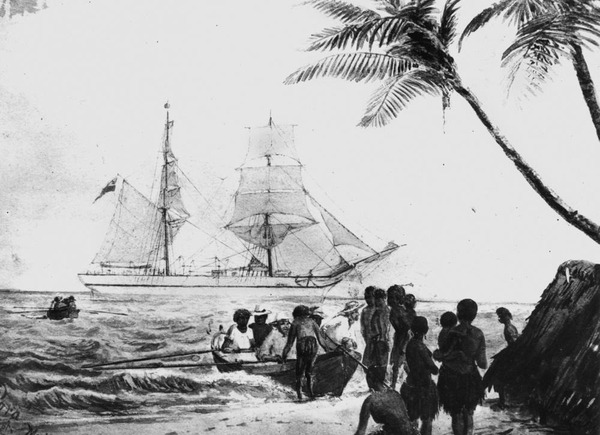
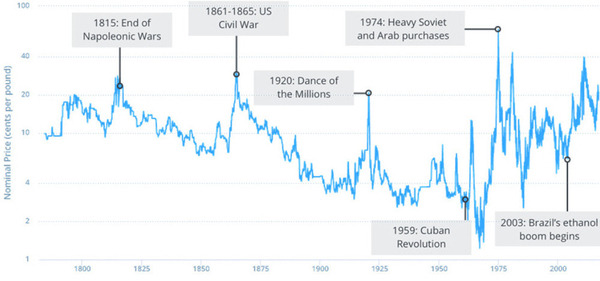
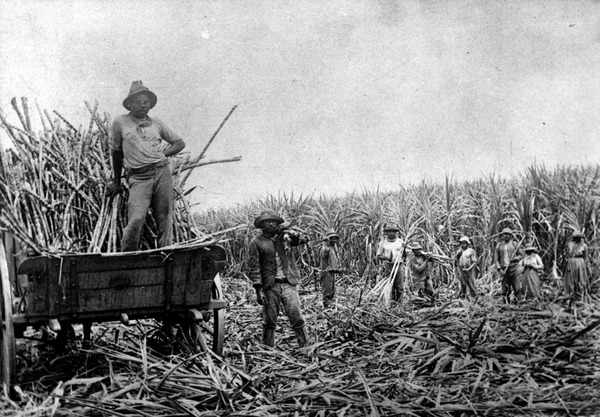
Tens of thousands of Pacific Island laborers were brought to Australia from neighboring Melanesian and Polynesian islands. In particular, Queensland, during the late 19th century, used these indentured laborers for work on sugarcane plantations. Estimates suggest around 60,000 to 80,000 humans were involved.
Fiji was another major destination and saw a significant influx of blackbirded laborers, with estimates ranging from 60,000 to 70,000 individuals. The sugarcane industry in Fiji heavily relied on coerced labor.
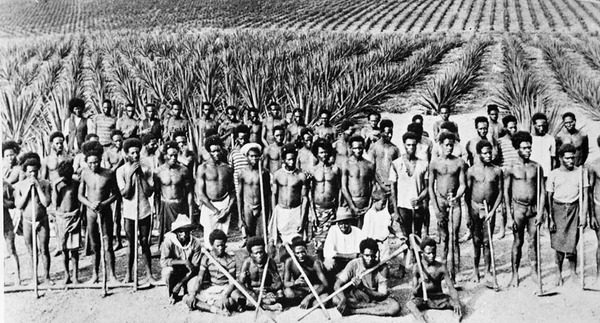
In Australia and other colonial powers involved in black birding, legislative measures were introduced to regulate and eventually restrict the recruitment of labor from Pacific Island nations. These measures aimed to improve labor conditions and protect the rights of indigenous populations. The practices associated with blackbirding were increasingly criticized by humanitarian and human rights advocates internationally. Reports of abuse, mistreatment, and exploitation of laborers led to growing pressure on countries involved in the practice to address these concerns. In various regions, including Australia and Fiji, labor reforms were introduced to address the unethical practices associated with blackbirding. The goal was to ensure fair treatment, appropriate wages, and better working conditions for laborers. Indigenous communities in affected regions began advocating for their rights and raising awareness about the mistreatment and exploitation they faced due to blackbirding. Their efforts contributed to increased attention on the issue and the need for change. As economies evolved and industries changed, the demand for labor through blackbirding diminished. Economic factors, coupled with increased awareness of ethical concerns, contributed to the decline of the practice. By the early 20th century, blackbirding had largely faded as a widespread practice due to a combination of the factors mentioned above. Many countries introduced laws and reforms to prevent the recruitment of labor through coercion and deception.
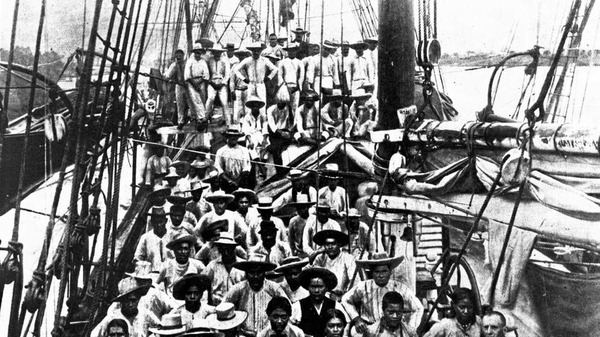
Formal Deportations of South Sea Island Laborers began in 1906 and continued until 1908. More than 7,500 South Sea Islanders were returned to their home country, though some had arrived in Australia at such a young age they would have had no memory of their exact origin. Indenture ceased in Fiji in 1911.
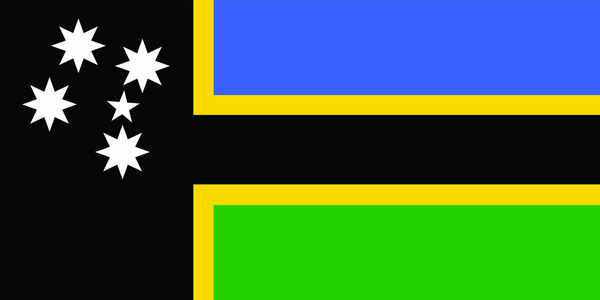
The official Australian South Sea Islander flag initially designed in consultation with the ASSI community. The flag was formally adopted in 1998. The color scheme incorporates colors resonant to people with forebears of which the three quarters of the trade were taken from the 83 islands of Vanuatu and are represented through colors green, gold and black, a third of the trade was from the Solomon Islands represented with blue, white, green. The overall flag is inclusive other parts of the South Pacific affected by Blackbirding as we are connected through the ocean blue and white stars.
While the formal abolition of blackbirding marked an important step in ending the exploitative practices, it's important to recognize that the legacy of blackbirding continues to impact affected communities to this day. The efforts to remember this history, address its consequences, and promote awareness of human rights and social justice continue in the affected regions.
SAFETY ALERT: A SAILBOAT HITS A REEF IN FIJI: LESSONS LEARNED
SAFETY ALERT: A SAILBOAT HITS A REEF IN FIJI
*LESSONS LEARNED*
Some people say that sailing in Fiji is so difficult that the longer one sails there hitting a reef at some point is unavoidable. And then, some people say that with careful planning, constant vigilance, sticking to vetted tracks on Open CPN, and a conservative eye on the weather, one can safely navigate in Fiji. AND, Anywhere on this continuum accidents can and do happen.
Last week a singlehanded sailor hit a reef in Fiji. Below we will be careful to only look at the facts for lessons to be learned and avoid armchair judgements. As mariners we want to know what went wrong and what lessons can be learned so that we can all be safer in the future.
Here is what we know happened:
- A single-handed sailor planned to sail from a marina in Fiji to an atoll. This requires entering the atoll through a clear passage in the reef. There is current to contend with and timing through the pass is very important.
- The route was pre-planned, and the timing was taken into consideration.
- Open CPN was up to date with a vetted track loaded to follow.
- A GPS dongle is used as a locating device for Open CPN on the computer.
- Navionics onboard as well.
- The morning of departure was cloudy and rainy so the computer with Open CPN had to be kept down below.
- A few miles out of the marina, the GPS was not tracking & Open CPN showed the boat still in the slip in the marina
- Sailor decides to use and follow waypoints on Navionics and continue as planned.
(NOTE: the waypoints used are unknown)
- When the sailor approached the reef, the weather was bad and there were whitecaps everywhere.
- The sailor could not see the reef in the whitecaps under the cloudy sky.
- The boat hit the reef outside entrance channel and off planned course to entrance.

Tracks showing routes entering pass and boat (red) off course pinned on a reef
Thankfully, with local help, the boat was freed of the reef, the boat is still afloat, and the captain is safe.
Take Aways from SV MONSOON:
- The boat is an old, stout, and thick fiberglass vessel: The Thickness of the hull was probably a saving grace.
- If the day dawns cloudy or stormy, consider waiting for better weather.
- Travelling through passages in reefs are best done under clear sunny skies mid-day for best visibility.
- Open CPN with up to date satellite charts and previously use tracks by similar boats are the best navigational aides in FIJI.
- If the GPS is not tracking, trouble shoot before continuing.
- No matter how many miles one has sailed, there is no room for complacency in Fiji.
Additional take away from SV AVANT
- Patience is often a mariners second best friend (with luck always being the first and best).

MUST SEE: LEVUKA, FIJI
MUST SEE: LEVUKA, FIJI 
THE ORIGINAL GUNKHOLES OF THE SOUTH PACIFIC


Levuka is a town on the eastern coast of the Fijian Island of Ovalau. Up until 1877, it was the capital of Fiji. Currently, this strangely haunted town has a population of about 5,000. It is the economic hub of the largest of 24 settlements on the Island. Levuka was designated a UNESCO World Heritage Site in June 2013, in recognition of the port town's exceptional testimony to the late colonial port towns in the Pacific Ocean.

The modern town of Levuka was founded around 1820 by European settlers and traders as the first modern town in the Fiji Islands. Levuka quickly became an important port and trading post in the Pacific. A disparate band of settlers made up Levuka's population- traders, missionaries, shipwrights, speculators, vagabonds, and even respectable businessmen. Much of Levuka’s unique heritage is in its wooden architecture (highly vulnerable to fire).

The South Pacific's first Masonic Lodge was built in 1913 and housed the Freemasons that were established in Levuka by Alexander Barrack in 1875. There is much controversy about the Masonic fraternity in Fiji. The dominant traditional Christian faiths consider the Masons to be devil-worshippers. The Masonic Lodge was burned down in the 2000 Fiji coup d'etat. The Lodge contained priceless historical artifacts and records of Levuka's history dating back to 1875. The arsonists have yet to be identified and prosecuted.











